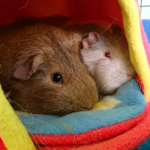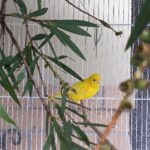The nutritional requirements of the domestic rat (Rattus rattus) have been studied extensively. This means that there are some great diets available to ensure they get the appropriate nutrition. Unfortunately, there is no regulation of the exotic animal pet food industry, which means there are also some rat/mouse diets that are not at all appropriate. An inappropriate diet can potentially shorten their lifespan by contributing to conditions such as obesity.
Balance & Quality
Rats are omnivores, which means their natural diet contains a variety of plant and animal/insect matter. However, when provided with an open pantry of various snacks, rats typically choose their ‘favourites’ which are usually the items high in carbs, fats and sugars! The majority of their diet as pets should be a formulated pellet/block, rather than a mix. A good quality pelleted diet allows for the various nutrients to be balanced according to actual requirements, and does not allow the rats to pick and choose the unhealthy options. The rest of the diet can be supplemented with fresh vegetables and small amounts of fruit. Other foods such as seeds, nuts and grains can be given as treats and to encourage foraging. Treats should make up no more than 5% of the diet. As this sector of the pet food industry is not at all regulated, it is important to choose a high quality brand such as Oxbow. BBEVS recommends the Oxbow Garden Select Adult Rat food for rats over 6months of age. For rats under 6months of age we recommend Oxbow Garden Select Mouse & Young Rat food. The pelleted diet should make up 80% of the diet. We choose Oxbow as they have a high level of research behind their diets, their diets contain beneficial ingredients such as flaxseed, and they have a highly comprehensive Guaranteed Analysis of each of their products. Remember – just because your rat likes something else more, doesn’t mean it is better for them!

In the wild, rats would spend a huge amount of their time foraging for food and much less time sleeping in comfy hammocks! As pets, they often tend to overeat, so you may need to consider restricting the amount of food your rats have access to. (These comfy hammocks are from Rockaby Rat Hammocks)

Oxbow Garden Select Adult Rat food is a nutritionally balanced block diet recommended by BBEVS. It should make up 75% of their diet. Oxbow have another diet that is designed for rats under 6 months of age, however this is not available in Australia due to importing restrictions. The main difference is the diet for younger rats is slightly higher protein and fat. We recommend supplementing rats under 6 months of age with approx 1 tsp of additional protein per day, such as cooked egg, insects, yoghurt, or cooked chicken.
Behaviour & Foraging
As with any species, some rats have great self-control and others like to snack a little more often than they should! Hence, some rats can be trusted with an ad lib supply of food and will eat just the right amount to stay lean and healthy. However, many require some restriction to their daily rations. Obesity in rats can also increase the severity of respiratory disease. In the wild, rats would spend many hours foraging for food. When feeding rats in a bowl, it is very easy for them to overeat with boredom. We recommend feeding your rats in as many different ways you can come up with and in multiple locations within their enclosure. Higher value foods (treats) should be used to encourage foraging or for rewards. Some ideas for foraging include:
- Hide your rats food in cardboard rolls, and stuff the ends with shredded paper
- Fill a kitty litter tray with Oxbow Hay, and hide some food or treats in here
- Wrap some foods in paper balls (once your rat figures this out, have some empty balls too)
- Place frozen peas or corn in a shallow dish of water (this one is particularly good on a hot day!). You can even use small rocks and pebbles for them to forage around.
TOXIC foods to avoid: avocado, garlic/onion, coffee, tea, alcohol, chocolate*
*Chocolate contains theobromine, caffeine and methylxanthine; which can be toxic. The exact toxic dose in rats is not clear, however the higher % of cocoa, the more likely toxicity is. For example: Nutella contains 7.4% cocoa solids. A pea sized amount of Nutella (approx. 1gm) should be safe for the average sized rat. However, some individuals could be more susceptible. Other chocolates with higher % of cocoa solids, so toxicity is a greater risk.

It’s a fabulous idea to change where and how you feed your rats, to encourage foraging behaviour and exercise. Why not make a simple foraging box?

Fresh veggies and smaller amounts of fruit should be provided daily. For adult rats, this should make up 20% of their diet.

In healthy rats, be sure to keep fatty and sugary treats to a minimum, this should make up the final 5% of their diet. These kinds of treats should be kept for encouraging foraging, as rewards for good behaviour (such as taking their medications), or to encourage sick rats to eat.

Rats are incredibly smart and can quickly figure out foraging toys!

There are lots of things you can recycle to make your own foraging toys such as these cardboard ribbon rolls. Try stuffing them with your rat’s favourite treats – remember that these foods are to be kept to a minimum. Feel free to share some photos of your own foraging toys!

This is not an example of a balanced diet, but of what our hospitalised rats may be offered. Note the larger amounts of softer and sweeter foods such as baby food (custard and fruit flavours), critical care, bird hand-rearing formula (often a favourite!), fruit and grain mix. This is only to encourage a sad/unwell rat to eat. Note how the food is in a shallow dish so thiat it is easily accessible. Unwell critters do not need to spend their extra energy foraging for food.



